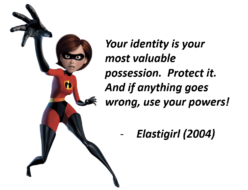Andy Harjanto, one of my really good friends at Microsoft, has just started Andy's InfoCard Blog – specifically dedicated to helping people understand and work with Microsoft's “InfoCard” Identity Selector and the Indigo programming environment. For those new to the discussion on this blog, an Identity Selector is a component of what we think of as an identity metasystem that works across platforms, vendors and technologies. It displays what we have codenamed “InfoCards”, that represent users’ relationships with identity providers, so that users can decide what identity to use with different “relying parties”.
Let me tell you a bit about Andy Harjanto. We've worked closely together since the early days of InfoCard thinking. Beyond the fact that he's absolutely great at what he does – making it all seem effortless – he has an amazing, hypnotising gentleness. So don't hesitate to contact him if you have problems of any kind trying out the Microsoft implementation.
His first posting tells you how to install our very early version (wireframe UI) of the “InfoCard” service for Windows. Because it is packaged with Indigo and Avalon, it's about a 30M download. I installed it on my Windows XP.
We didn't want to put up a public “relying party” site for this beta (we will do this later in the process when we have a more realistic UI and want a wider audience involved.) So you need to download Visual Studio Express (I think that was about another 35M) in order to try out a “hello world” application.
One of the best reasons to try it out is to see how the identity selector integrates with the new Indigo WS programming environment. And don't worry. You don't have to get into gobs of details to try things out. It's very simple and you can stay at a high level.
Please note that the first beta only supports self-asserted identities (the next one will add managed cards for third party providers). And the UI is nothing like the final product – and doesn't show off the privacy features. But the beta does demonstrate our use of the protected subsystem, private desktop and WS-Trust – all the really hard underlying technical issues. One of our top goals is to keep everyone in the industry informed about what we are working on, demonstrating how easy it will be to take advantage of this technology from other platforms. We also want Windows developers to start understanding the technology and thinking about applications based on identities.
Andy is publishing a guide that shows how to write a tiny relying party service and a “hello world” client apllication that wants to connect to it. The demo shows what you need to do to configure the relying party to accespt InfoCards (namely change a few lines in the service's configuration file).
I believe we can get to the point where accepting “InfoCards” is just a matter of configuring your web service (already the case in Indigo), or adding a few tags to your web page – if people building web servers want to do it. So, I need to get back to work.

 I'm a fan of Don Park's blog. The remarkable story which precedes this posting is an example of how interesting it gets. I particularly like the “feeling” he projects.
I'm a fan of Don Park's blog. The remarkable story which precedes this posting is an example of how interesting it gets. I particularly like the “feeling” he projects. 
 I've been trying to explain my thinking about Microstandards. I see these as being standards objects that can be combined and specialized to define complex distributed systems. I thought I might help others understand what I'm saying by picking an example and discussing it.
I've been trying to explain my thinking about Microstandards. I see these as being standards objects that can be combined and specialized to define complex distributed systems. I thought I might help others understand what I'm saying by picking an example and discussing it.